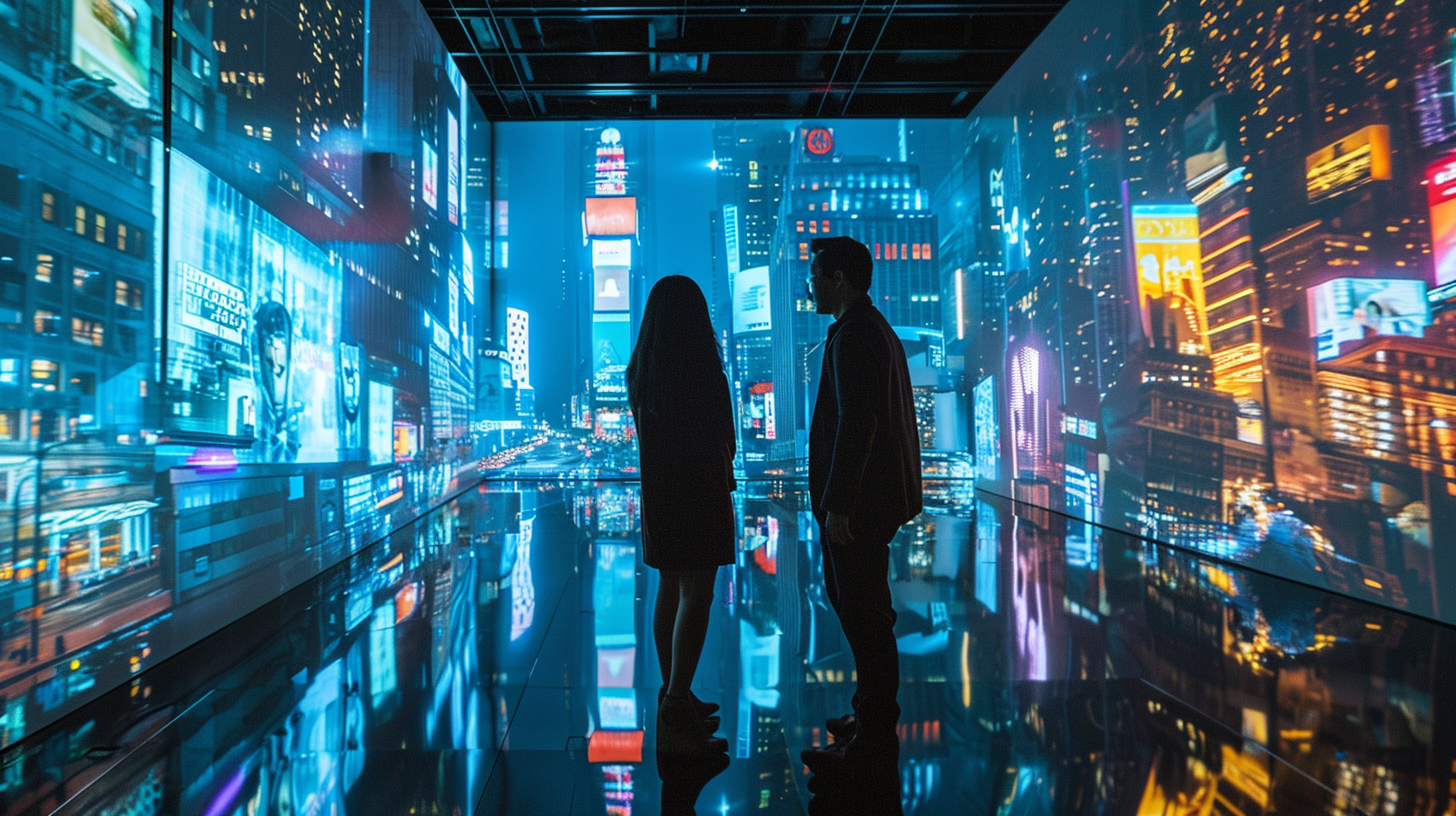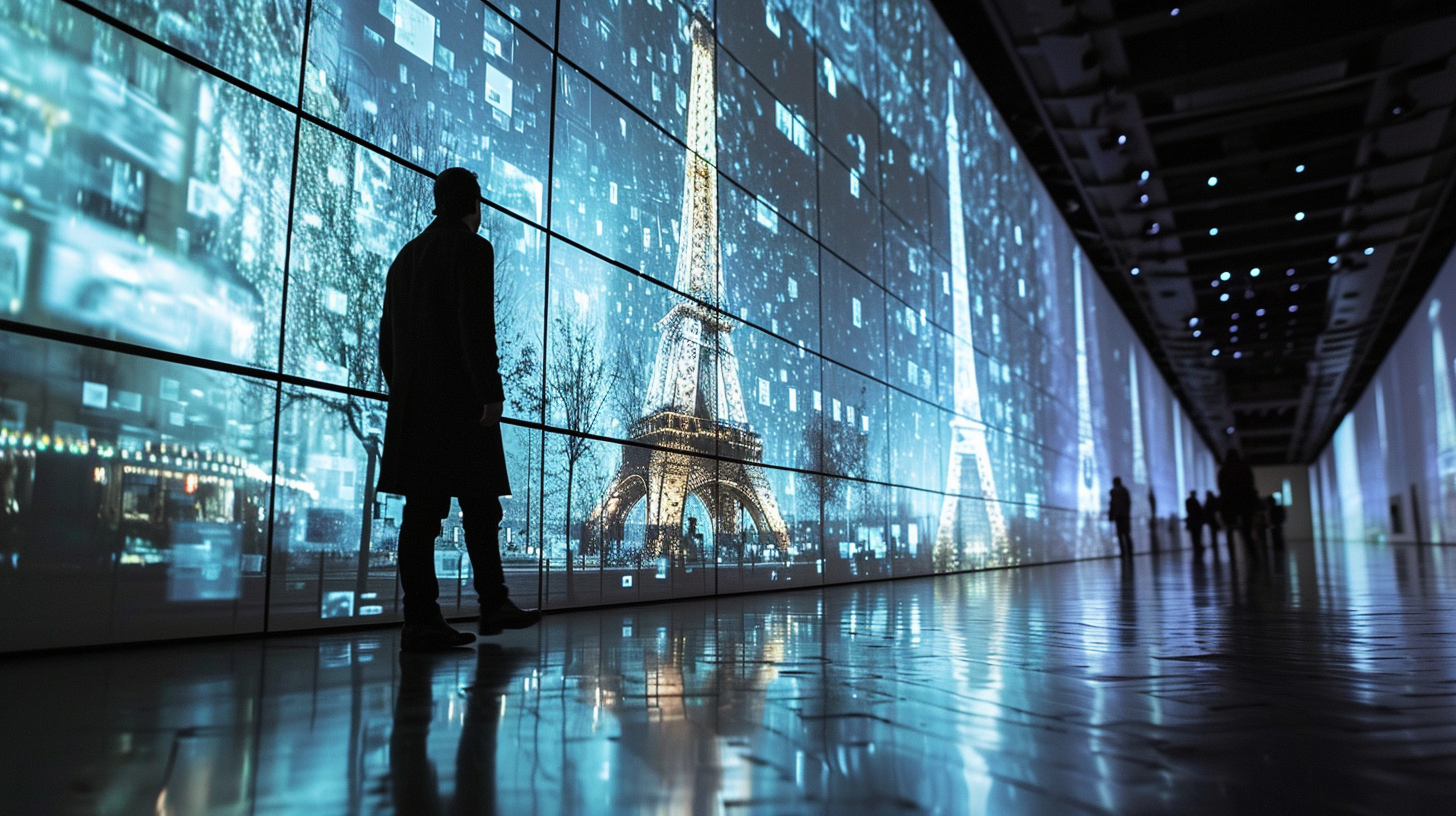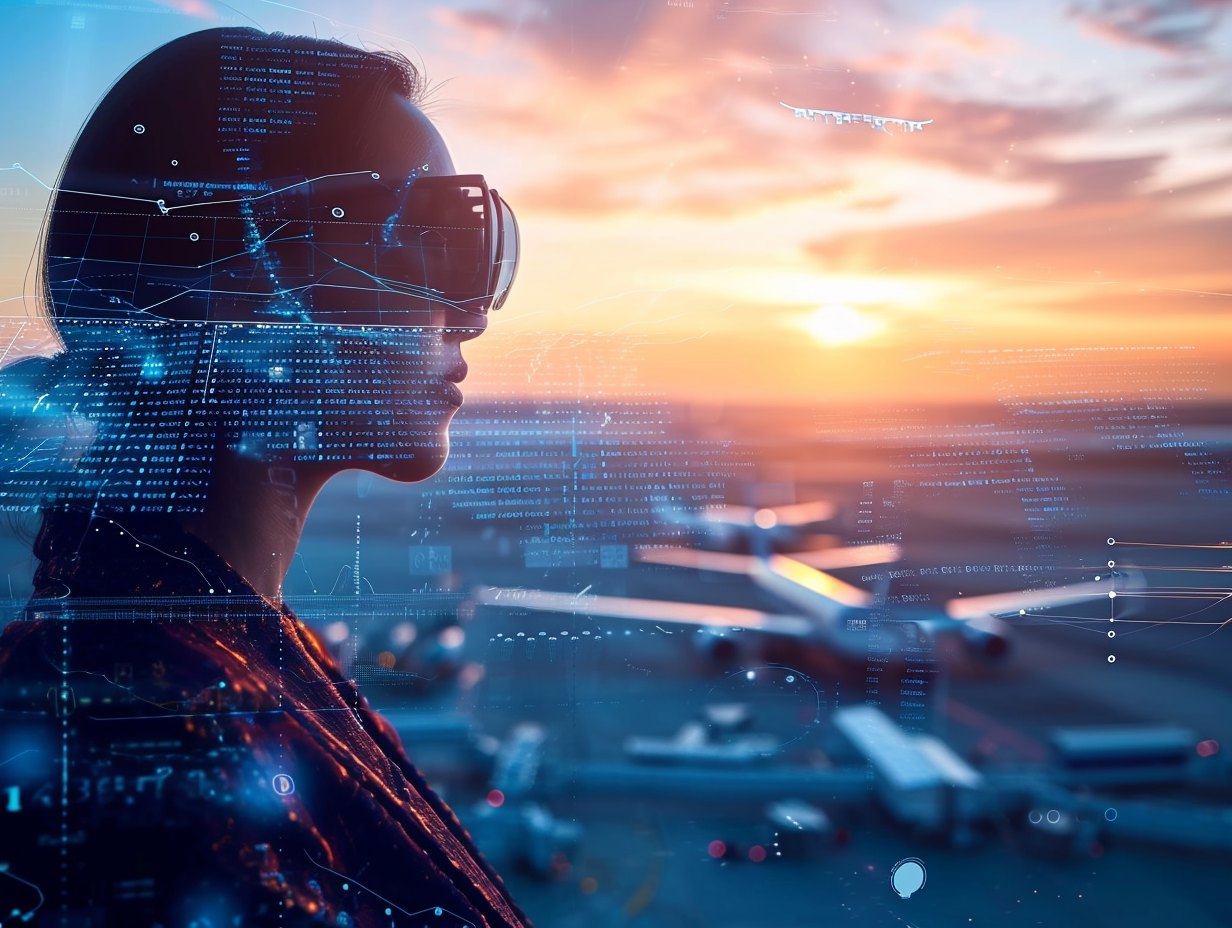It’s not that hard to imagine a futuristic world where each travel experience is meticulously crafted to your unique preferences. A time when virtual explorations precede physical journeys and then seamlessly blend into one extraordinary adventure.
However, this vision is rapidly becoming a reality in today’s travel industry already. All thanks to how digital twinning and artificial intelligence (AI) are weaving together unprecedented adventures and experiences.

A Glimpse Into Travel’s Technological Evolution
Before we explore the future of travel, let’s turn a few pages back to the early 2000s. Back then, travel planning was akin to a tedious orchestra of bulky guidebooks, phone calls to hotels, and paper maps to navigate unfamiliar streets so you could compose a flawless vacation.
Fast forward to the present, and you’ll discover a profound transformation. Virtual reality tours of hotel rooms or museums, now offer glimpses of upcoming adventures via the digital space. Intelligent algorithms present personalized travel suggestions to ensure hassle-free travel planning. And GPS and mobile travel apps have become the norm in helping us navigate cities via live digital guidance.
What’s even more surreal is that this may just be the start of a more fantastic journey as we all step into an even more exhilarating phase in the era of digital twins and AI.
Imagine having a digital counterpart of your preferred travel destination easily accessible within your mobile to offer real-time, interactive glimpses of what awaits you. These digital twins, powered with AI, can also evolve dynamically, learning and adapting to your changing preferences and behaviors to ensure each journey is more than a trip but your own tailor-fit adventure waiting to unfold.
It’s always about the journey. So, as we dive deeper into the mechanics of these transformative technologies, let’s also delve into their current impact on travel and the expansive possibilities they can offer for the entire industry’s future.
Demystifying Digital Twins and AI
Each journey to new and uncharted territories begins with a first step. For this journey, let’s first grasp what digital twins and AI actually are. More importantly, how they are transforming the current travel landscape.
‘Digital twins,’ in their simplest form, are virtual models of physical entities. Think of them as mirror images that live in the digital world. They replicate real-world locations, objects, or systems, capturing their essence in astonishing detail.
This emerging tech is taking great strides and the International Data Corporation (IDC) has offered an exciting prediction. It claims that by 2027, a staggering 60% of new physical assets and processes will transform into digital twins— a revolutionary shift set to reshape entire industries, heralding a new era of innovation and efficiency. Soon, we’ll witness a world where the boundaries between physical and digital are but a thin line.
The same also applies to our travel experiences. Infuse these digital replicas with AI, and you’ll have an intelligent, interactive entity that not only mimics reality but also learns from it. AI serves as the brain of these digital twins, enabling efficient data analysis, trend prediction, and personalized experiences according to your unique and discerning tastes in travel.
Perhaps the magic that digital twins in travel offer lies in their ability to bring distant places to life right before your eyes. Say one day you’re sitting in your living room in Boston, and suddenly you develop an urge to stroll through a digital twin of Paris. AI can suggest the perfect café based on how you take your coffee, be it black, with two sugar cubes or with cream, no sugar. Or it can lead you to a virtual tour of a small-town cinema that aligns with your penchant for film noir. Digital twins can instantly transport you into a clearer glimpse of what you were imagining for your next travel plans just one moment ago.

Of course, the application of digital twins and AI extends far beyond these immersive experiences. In the vast expanse of world travel, they also have the potential to revolutionize everything from planning and booking to experiencing and making the most out of the actual journey. Airlines are already experimenting with digital twins of aircrafts for maintenance and operational efficiency. Hotel chains (like Raddison) are exploring virtual replicas of their properties, allowing guests to choose rooms not just based on pictures but through digital experiences.
These technologies are not confined to the fringes of our imagination. They are already taking shape, influencing how we plan, experience, and remember our travels. This leads us to explore AI’s emerging role in today’s travel industry and how it sets the stage for an even more integrated future with digital twins.
AI’s Evolution in the Travel Industry
AI’s integration into the travel industry is a narrative that tells of a gradual yet impactful transformation. From its nascent stages to its current prominence, AI has steadily become an invisible yet indispensable companion to travelers and service providers alike.
In its early stages, AI in travel was limited to basic automation and data analysis. These days, it has come a long way from simply guiding your routes through GPS and telling you which roads are congested during rush hour to a more holistic, intelligent, and empathetic lifesaver. Its presence is now felt across the entire travel spectrum.
From powering customized recommendation engines to predicting your preferred destinations and activities based on your past behaviors and preferences, AI has become your personal assistant of sorts. It is the intelligence behind the chatbots that cater to your every need 24/7. It’s the brains that answer your queries and resolve real-time issues. AI even plays a role in price optimization, helping consumers and companies make informed decisions for better win-win offers on the competitive market.
Arguably, the true essence of AI’s impact on travel – Applied AI as we call it – lies in its ability to understand and anticipate the traveler’s needs. After all, travel should be about crafting unique and personal experiences. For instance, AI algorithms analyze vast amounts of data to suggest travel itineraries that match your interests, preferences, and budget, making each trip not just a vacation, but a story you can cherish and share with your circle.
From the looks of things, stopovers are not part of AI’s continuing journey in travel. Its integration further deepens with the advent of digital twins. This means that AI’s predictive and analytical capabilities will not only enhance virtual experiences, but also streamline operational aspects.
For one, digital twins of tourist destinations could provide real-time updates and insights, allowing for better crowd management and resource allocation and ultimately elevating your travel experiences while preserving the destination.
In the next section, we’ll explore how digital twins are emerging as a groundbreaking technology in the travel industry, offering a glimpse into a future where virtual and physical worlds converge seamlessly.
Digital Twins: Bringing Destinations to Life
Digital twins are so much more than mere simulations. They are dynamic, interactive canvases that unprecedentedly bring real-world destinations to life wherever you are.
The entire concept of a digital twin in travel is exhilarating. It can create virtual models of cities, complete with their architecture, culture, and ambiance. And these models aren’t static; they evolve in real-time, mirroring changes in the actual cities as they happen.
An easy metaphor to understand a digital twin is to consider your experience with Google Maps when it prompts you with an alternative route (“This route will save you 4 minutes”). It has taken all its data inputs–your speed of travel, your destination, road congestion, traffic lights, and more–and has calculated that it is more efficient for you to explore a different option.
And speaking of Google Maps, it doesn’t take much imagination to see the advances that are being made to create a parallel virtual world and its application for travel. Check out some of their
For travelers, this presents the ability to explore and interact with a destination before they even set foot in the actual place. Thanks to digital twins, you can walk down virtual streets, explore local markets, and even experience cultural events live in the virtual space all from the comfort of your home. This tech fusion can simulate scenarios based on different times of the year, weather conditions, or special events, providing a comprehensive preview of what your actual trip might entail.
Considering how the implications for trip planning remain complex, digital twins are set to enable a level of stress-free exploration and customization previously unattainable. You can virtually visit hotels and compare rooms and amenities before you book a stay. Tourist attractions and neighborhoods come alive in your living room, helping you craft a workable itinerary and significantly reduce the risk of botched travel plans.
Then there are also the potential benefits digital twins bring to the table for sectors in the tourism industry and governments. They pave the way for better destination management, can help SMEs in the sector gain insights through big data, and even help push sustainable tourism globally.
This takes us to another glaring opportunity in the next section.
Digital Twins as Strategic Tools for Destination Marketing Organizations (DMOs)
Digital twins also present a transformative opportunity for Destination Marketing Organizations (DMOs) to innovate their marketing campaigns. By harnessing the power of digital twinning, DMOs can create highly effective, data-driven strategies that not only showcase destinations in unique ways but also predict and simulate the outcomes of different marketing paths.
At the start of 2023, www.expedia.com reported that 46% of travelers felt the importance of travel post-pandemic. However, 49% are still careful about their physical and mental health, which may contribute to hesitation about long-term travel. These kinds of insights motivate 54% of DMOs to acknowledge and invest in the importance of data for their 2024 marketing plans.
Picture this: a DMO plans to promote a coastal city. Instead of traditional methods, they employ a digital twin of the city, integrating it with a wealth of data— from tourist behavior patterns to economic indicators to security and safety strategies. This digital twin becomes a sandbox where various marketing strategies can be tested and their impacts simulated.
Say the DMO might want to assess the effect of focusing on the city’s cultural festivals in their campaign versus highlighting its nature trails and outdoor activities. In the digital twin environment, they can create and deploy both campaigns virtually, better analyzing various facets of concern and impact points. AI can help manage tourist flows to prevent excessive foot traffic and reduce the ecological footprint. It can also forecast the potential economic impact of each campaign, assisting DMOs, authorities, and businesses to balance tourist attractions with sustainability and community safety and well-being.
Given this, AI certainly plays a pivotal role in multiple processes, especially when manually sifting through vast datasets to predict outcomes can be too tedious. The tech can now simulate how different demographic groups respond to various campaign elements. This provides DMOs insights into which strategies are likely to be more effective.
Such an approach also offers more advantages. First, it allows DMOs to experiment with creative ideas without incurring the high costs and risks associated with real-world implementation. It also provides a valuable understanding of the potential effectiveness of different marketing strategies, enabling companies to optimize what they offer for the best strategic results.
The Fusion of Digital Twins and AI in Revolutionizing Travel
Indeed, the synergistic relationship between digital twins and AI is a welcome enhancement for travel tech. Pinpoint accuracy in developing personalized, immersive, and sustainable experiences is now within a touch of your mobile’s screen.
These intelligent, responsive entities that cater to your specific needs and preferences can now highlight the most relevant recommendations, offers, and hotspots to make your travel journey genuinely unforgettable.
Whether you seek architectural details, historical facts, or cultural anecdotes, this level of personalization extends beyond the virtual world, as the insights gained from your interactions with the digital twin can further inform and enhance your physical visit.
For travel businesses, combining digital twins and AI means more efficient operations, enhanced customer satisfaction, and innovative business models. Hotels, airlines, and travel agencies can use these technologies to optimize resource management and create new and compelling marketing strategies.
Envisioning the Future: Innovations and Opportunities in Travel Technology
As we peer into the horizon of travel technology, the fusion of digital twins and AI not only paints a picture of what greater heights the travel industry can achieve but also opens doors to uncharted innovations and opportunities. The future of travel, influenced by these technologies, promises to be more than another journey: it becomes an integrated experience, seamlessly blending reality with the digital – the digitization of everything, one of the 5 global disruptors I have been fascinated by for more than a decade.
One of the most exciting prospects is the development of fully immersive travel experiences. Imagine virtual reality (VR) and augmented reality (AR) technologies integrating with digital twins and AI to create lifelike experiences that blur the lines between virtual and physical travel. This could be a game-changer for people with mobility issues or those who wish to experience remote, dangerous, or even imaginary destinations.
In responsible tourism, digital twins and AI could lead to the creation of ‘smart destinations.’ These are places where every aspect, from energy consumption to tourist flow, is optimized to align with sustainable development goals and environmental protection. AI algorithms could predict peak tourist seasons and manage them effectively to reduce environmental impact while improving the quality of the visitor experience and opening avenues for more jobs in local tourism sectors.
The future also holds a great potential for AI-driven personalization to reach new heights. Travel services could evolve to offer hyper-personalized experiences based on a nuanced understanding of individual preferences, past experiences, and even emotional states. The result? Every trip you take feels like it was designed exclusively for you.
In TravelAI’s own web and brand development we can use digital twins of entire websites to simulate a user’s experience before cutting a line of code, gaining advanced insight into revenue performance and traveler engagement.
As mentioned, the implications for travel businesses also remain bright. The wealth of data generated by digital twins and AI could lead to more dynamic pricing models, innovative service offerings, and enhanced operational efficiency. There’s also the potential for entirely new business models to emerge, which we have yet to even imagine.
Conclusion: Embracing a New Era in Travel
As our journey through the evolving landscape of travel technology comes to a close, we stand at the precipice of a new era— where the lines between physical and digital, reality and simulation, are not just blurred but harmoniously intertwined. The fusion of digital twins and AI is a paradigm shift in how we experience, interact with, and understand travel.
Reflecting on this exploration, it becomes evident that the future of travel is one that is richly personalized, deeply immersive, and conscientiously sustainable. We’re entering a world where travel experiences are tailored to individual preferences and needs, where destinations can be explored virtually with a depth and realism previously only imagined in sci-fi movies.
This technological revolution also brings with it a responsibility. As we embrace these advancements, we must also be mindful of their implications— from ethical considerations to data privacy to balancing technological allure with real-world impact.
The goal should not solely be to enhance the travel experience, but also to ensure that these technologies are used in ways that benefit the traveler, destinations, local communities, and the environment.
Now that we know how integrating digital twins and AI in travel opens up a universe of exciting possibilities, one thing is sure: the way we explore the world is set to be transformed in ways we are only just beginning to comprehend.





